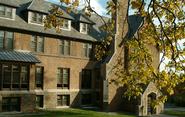
A strong interest in integrating green design into its 200-year-old campus has led Hamilton College to incorporate environmental sensitivity and sustainable design in its renovation projects. As Earth Day approaches, Hamilton announces that Skenandoa House, an 84-year-old residence hall renovated in 2004, has been awarded a Silver LEED® (Leadership in Energy Conservation) Certification by the U.S. Green Building Council. This certification makes Skenandoa House the oldest building in New York State to be so designated.
LEED certification of building projects is difficult to achieve, since the projects must meet or exceed myriad requirements. Five environmental categories are defined in LEED including: sustainable sites, water efficiency, energy and atmosphere, materials and resources and indoor environmental quality. Only eleven other buildings throughout New York State have been LEED-certified since the program began in 1999.
"The Skenandoa House is a building the students and community can be proud of," said Rick Fedrizzi, President, CEO and Founding Chair, U.S. Green Building Council. "This campus building will serve as a showcase for high-performance, energy-efficient, healthy buildings, and an inspiration for other colleges."
Built in 1922, the former Psi Upsilon chapter house was rededicated as Skenandoa House in 2004 in honor of the Oneida Indian chief and friend of Samuel Kirkland. In 1794 Kirkland founded the Hamilton-Oneida Academy that later became Hamilton College in 1812. The third college to be established in New York State, it is today among the oldest in the nation.
Historic and environmental stewardship were powerful allies in the process used by the architectural firm EwingCole to help Hamilton make Skenandoa House a model for environmentally responsive residence hall renewal on campus.
In addition to careful workmanship that restored the building's exterior to its original grandeur, the most notable feature is the use of "green" technology throughout. The renovations included a 16-well geothermal ground water heating and cooling system, individual thermostats in each room, energy efficient lighting, extensive building materials reuse and construction waste management.
Steve Bellona, associate vice president for facilities and planning at Hamilton College, said, "Not only does Skenandoa House consume significantly less energy per square foot than our other relatively new residence halls, but our cost for renewable electrical energy, on a square foot basis, was less than other residence halls using non-renewable fossil fuels. This is an experiment for us, but so far we are pleased with the payback."
In its first year of operation, the geothermal system in Skenandoa House used 250% less energy per gross square foot than a standard gas-fired heating system in a comparable residence hall (47.6 mbtu/gsf vs. 123.2 mbtu/gsf).
The efficiency of the geothermal system is its overwhelming advantage. While conventional heating and cooling devices must convert outside temperatures to reach comfort levels, geothermal heating and cooling uses ground temperatures of around 55 degrees to help moderate the temperature differential. The process requires only electricity to run a heat pump and small circulation pumps, eliminating the use of natural gas.
All electrical power used in Skenandoa House is completely "green power" (wind, biomass, small hydro). While more expensive to purchase, green electrical power has reduced greenhouse gas production in carbon dioxide by 107.1 tons, nitrous oxide by 289.5 pounds and sulphur dioxide by 765 pounds. By purchasing 100 percent green power, Hamilton is also a member of EPA's Green Power Partnership.
